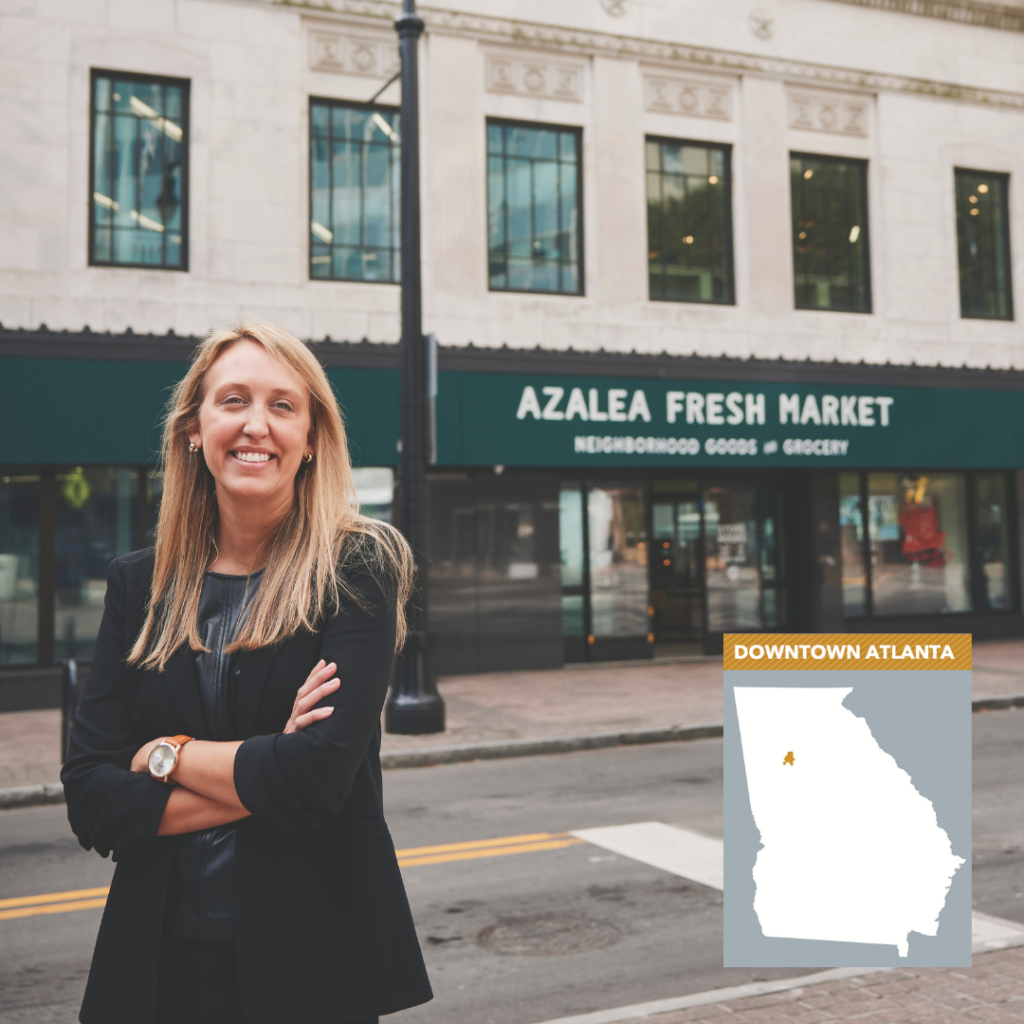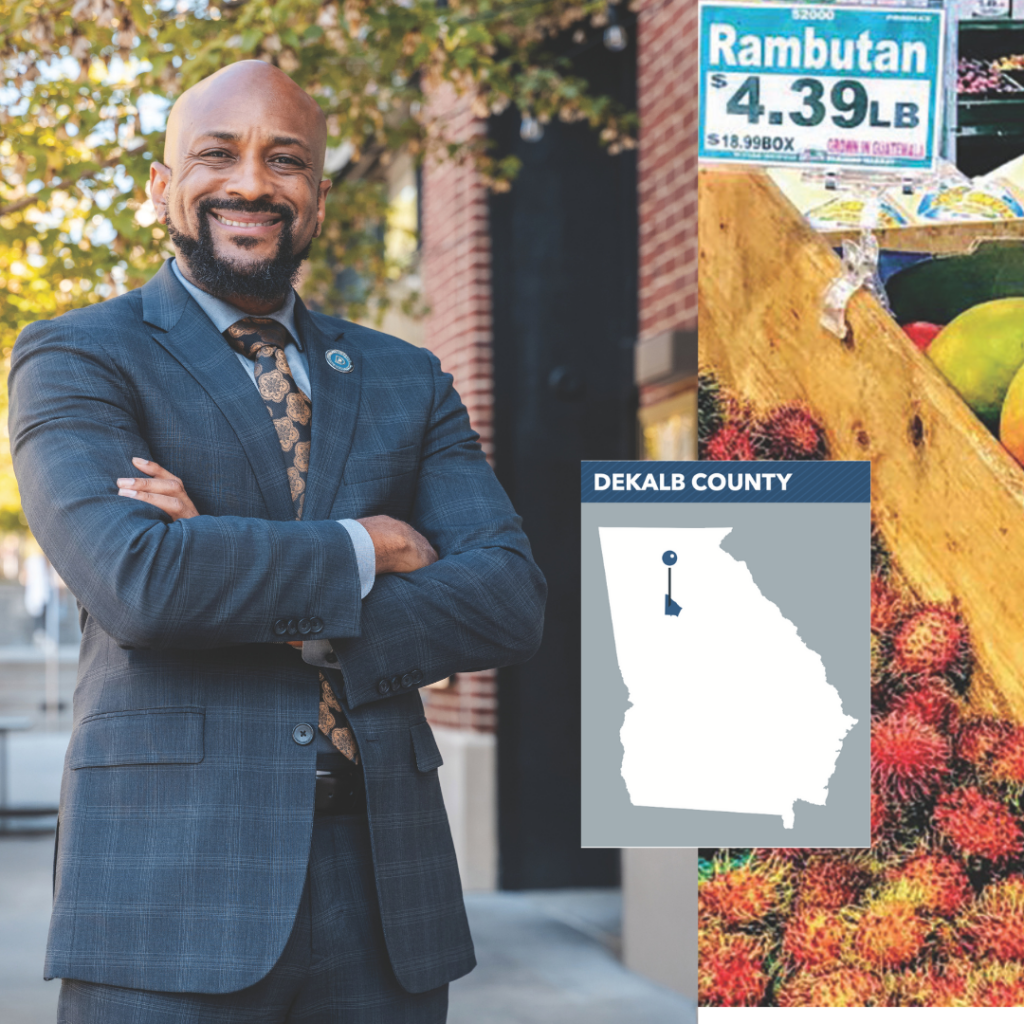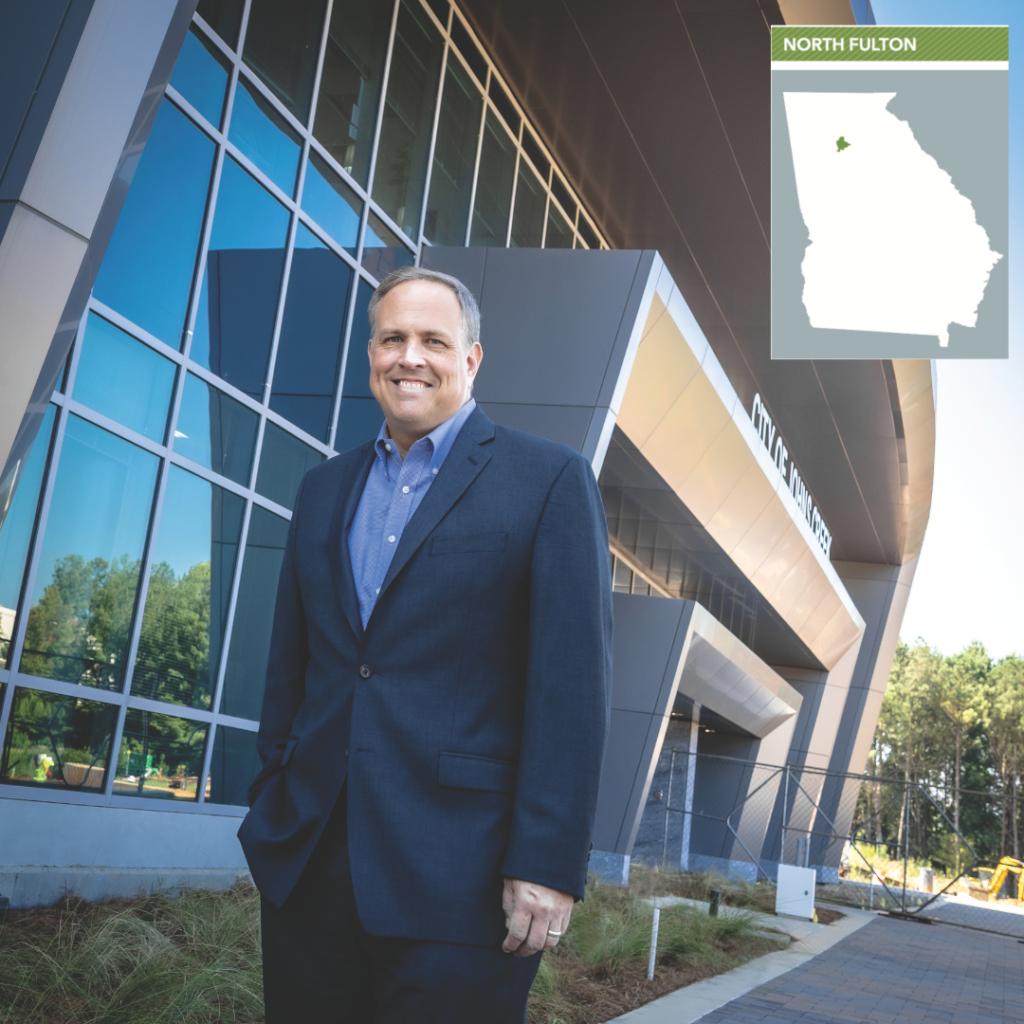Cobb County CIDs: Leading, Innovating and Enhancing
Cobb County CIDs are boosting the region with improved transportation, mobility and accessibility.

It’s hard not to get excited about what is going on in Cobb County when you talk to the executive directors of the Cumberland, Town Center and Gateway Marietta Community Improvement Districts, or CIDs. All three are working on master plans that envision improvements over the next 10 to 15 years, but they already have produced an impressive pipeline of projects.
CIDs are designated areas where businesses tax themselves voluntarily to fund projects within the district, such as road construction, landscaping, water and sewage systems, signage and wayfinding, and public transportation systems. The work of the CIDs increases property values for businesses inside the district while improving quality of life for residents, who don’t have to pay extra taxes.

Popular Attraction: Atlanta Braves’ Truist Park and The Battery Atlanta attracted more than 10 million visitors last year. Photo credit: contributed
Their cumulative economic impact in Cobb County over the past 36 years totals more than $23 billion, including growing the tax base that supports the highly ranked Cobb County public school system.
What the CIDs have learned over the years is that the best strategy for improving business in the area is to make the district a desirable place not only to work, but to visit and live.
They have collaborated with multiple public organizations, including the county government, the Georgia Department of Transportation (GDOT) and the Atlanta Regional Commission (ARC), to fund the planning and implementation of major projects, from highway access ramps and bridge repairs to greenspace and trails.
“CIDs have proven to be the best partners of the Livable Centers Initiative [LCI],” says Samyukth Shenbaga, managing director of community development at ARC. “They have real money to focus on transportation and implementation of projects.”
The LCI is a grant program that promotes walkable communities and increased mobility options, helping provide improved access to jobs and services. The Cumberland and Town Center CIDs recently both received sizable LCI grants to study ways to improve livability in those communities.
Changing With the Times
The 6.5 square miles of the Cumberland CID are home to some of the most popular attractions in Metro Atlanta, including the Atlanta Braves’ Truist Park and the Chattahoochee Nature Recreation Center. Add the Cobb Energy Performing Arts Center, home to the Atlanta Opera and the Atlanta Ballet, and the CID has something for everyone.
“Cumberland is a major jobs center,” says Kim Menefee, executive director of the Cumberland CID. “We want to make it accessible to people with or without cars.”

Reducing Accidents: A reversible ramp under construction from Interstate 75 to Akers Mill Road gives express lane drivers direct access to the Cobb Galleria complex. Photo credit: contributed
With more than 88,000 jobs in the district, the Cumberland CID is planning highway infrastructure projects to improve access to the area. A reversible ramp currently under construction from Interstate 75 to Akers Mill Road gives Cumberland’s commuters safer direct access from the express lane of the highway to the Cobb Galleria complex, reducing potential accidents caused by changing lanes to exit. The ramp is expected to be completed by the first quarter of 2025.
When the Atlanta Braves announced in 2013 that the team was moving to Cobb, development skyrocketed – especially with construction of the mixed-use Battery surrounding the new ballpark – and residents and visitors followed. In the past decade, the population in the Cumberland CID has grown by 27% to more than 30,000, almost twice the rate as the rest of Cobb County. Truist Park and The Battery Atlanta alone attracted 10.3 million visitors in 2023.
“The Cumberland area is considered the next boomtown,” says Menefee. “The influx of a younger, more diverse population is the biggest change in the past five years.”
Those changing demographics also meant the CID tweaked its list of projects to do more than just give people access to the area. It’s helping them travel between attractions.
Cumberland is home to 38 miles of urban trails, part of a planned 60-mile trail network throughout the district. The fourth and final mile of the Bob Callan Trail connects the Chattahoochee River National Recreation Area through the main Cumberland business district to Windy Hill Road. Scheduled for completion in May 2025, improvements include a new trailhead with a workout area, seating and bike sharing.
The planned 3-mile Cumberland Sweep embraces the idea of “last mile connectivity” – letting visitors and residents leave their cars and walk, bike or ride the Hopper, a free, autonomous electric shuttle, to all the major attractions in the area.
As part of the Cumberland Sweep, two pedestrian bridges over Cobb Parkway allow visitors and workers, including many of the 7,000 hospitality and food service workers who rely on public transportation, to safely enter the district from Smyrna.

Under Construction: Rendering of the expansion of the Bob Callan Trail, which will include boardwalks, a bridge spanning a creek, a viewing overlook and resting areas with benches at trail access points. Photo credit: contributed
Construction on the first section, connecting the Cobb Energy Performing Arts Center and Cobb Galleria to Interstate 285, is scheduled to begin in 2027 and be completed in 2028.
The Cumberland CID also hosts 840 acres of the Chattahoochee River National Recreation Area (CRNRA). Built in 1978, the Paces Mill/Palisades entry is a destination for fishing, boating and connecting to trails, including the trailhead for the Bob Callan Trail.
“Paces Mill/Palisades is the most popular unit of the Chattahoochee River National Recreation Area, with 270,000 visitors a year, but there has been no significant investment since the 1970s,” says Menefee.

Recreation Area Upgrade: The New Day Palisades project is being done in two phases. Phase 1, illustrated in the rendering below, includes a new parking lot and picnic area. Phase 2, illustrated in the rendering to the above, includes an information center and river steps under the Cobb Parkway bridge. Photo credits: contributed
The New Day Palisades project, a $15.8 million partnership with the CRNRA, is scheduled to break ground this month.
Phase 1 includes a new parking lot and entrance design, as well as a new picnic area. Two new river access points with overviews and river steps give visitors safer access to the river for boating or fishing. New bioswales fix drainage issues and filter water back into the river to control flooding. These improvements are scheduled to be completed by Memorial Day 2025.
“We want to create a more ‘national park’ experience,” says Menefee.
Phase 2 of the project includes an information center with restrooms and changing facilities, updates to the existing west-side parking lot and new river steps under the Cobb Parkway bridge. Funding is still being secured, with plans to break ground in 2025 or 2026.
“Our goal is to continue to transform Cumberland into a community where people want to work, live and visit,” says Menefee. “We do that by investing in key transportation and lifestyle enhancements that will continue to support Cumberland growth.”
Community Comes First
The Town Center CID has also seen its demographics change. Created in 1997, the 6.25-square-mile CID is home to Kennesaw State University (KSU), Town Center mall and Cobb County International Airport. The number of jobs in the CID grew 60% in the past 15 years, and as housing prices climbed inside the Perimeter, younger people moved farther out – including to the Town Center area. The CID now has more than 13,000 residents, 41% of whom are under 25 years old, in part because the student population of KSU has more than tripled since 1997.
Pioneering Change: The Town Center CID’s projects include several firsts, like the the Skip Spann Connector being Cobb’s first lighted bridge, above, the first bikeshare program in the county, below left, and the area’s first bridge mural, middle, according to Tracy Styf, the CID’s executive director, below right.
“When people ask me ‘What is a CID?’ I tell them the C stands for community and that is the most important part of a CID,” says Tracy Styf, executive director of the Town Center CID. “Creating the CID allowed Town Center to compete more effectively with neighboring regions for business investments, jobs and residents. In addition, it ensured improvements and investments aligned closely with local priorities and needs.”
The CID wants those younger people to hang around after they graduate, to work and raise their families. So CID leaders are trying to think creatively – not just about bringing in jobs but making it a place people want to live.
“We pride ourselves on being innovative,” says Styf.
Its community-building solutions and funding improvements include the first lighted bridge, first bridge mural and first bikeshare program in Cobb County. The CID was also the first to create a nonprofit partner to diversify its fundraising.

Massive Project: Phase 3 of the South Barrett Parkway Reliever will reduce traffic on the parkway by 22%. Photo credit: contributed
The Town Center Community Alliance, created in 2013, can access funds from places the CID can’t, including foundation grants, other charitable organizations, and private and corporate donations. The current crosswalk pilot project is a result of the CID’s partnership with the Alliance. It combines safety enhancements with art installations at crosswalks along the Noonday Creek Trail.
“The Town Center Community Alliance is a tool in the CID toolbox,” says Styf. “Having a nonprofit partner means we can tap into a wider range of funding opportunities. With the Alliance, we can adapt to emerging needs in the community.”
Keeping on Track
Ongoing projects include Phase 3 of the South Barrett Parkway Reliever project, the final step of the biggest project in the CID’s history. It will reduce traffic on Barrett Parkway by 22%, with new roundabouts, larger sidewalks and crosswalks and additional bike lanes. The project is due to wrap up in spring of 2025.
Also planned for the district is technology implementation for the Regional Connected Vehicle Program. The project, led by ARC and GDOT, adds smart technology to 54 traffic signals in the CID (and around 1,000 others across the region) that can detect and react to traffic patterns, reducing the time it takes emergency vehicles to reach their destinations, giving priority signals to freight and transit traffic, and notifying drivers when lights are changing, giving them more time to stop safely.

Crime Prevention: Caroline Whaley, executive director of the Gateway Marietta CID, says the GMCID works with police and Flock Safety on measures that help reduce illegal activity. Photo credit: Kevin Garrett
Many of the CIDs’ long-term plans are interconnected projects around George Busbee Parkway.
“George Busbee is the spine of our district,” says Styf. “It serves as a major north-south connection between the KSU campus and the Town Center at Cobb mall area.”
Planned improvements include well-lit sidewalks, trails and bike lanes, and connections to public transportation.
The corridor improvements will become part of the Town Center Loop, a 7-mile trail connecting pedestrians and cyclists to all the major destinations in the area. An additional path connecting George Busbee Parkway to Cobb Place Lane across I-75 encourages not just walking, running and biking but creates places to gather, including parks, play areas and easy access for food trucks.
A Unified Vision
Established in 2014, Gateway Marietta is the youngest CID in Cobb County. Developed to revitalize the business district between South Marietta Parkway, Franklin Gateway and Delk Road, this 1.2-square-mile area lies inside the city of Marietta. The CID’s projects focus on beautification, infrastructure and public safety and align with the city of Marietta’s vision.
“The city of Marietta is our largest partner and supporter,” says Caroline Whaley, executive director of the Gateway Marietta CID (GMCID).

Soccer Center: The Children’s Healthcare of Atlanta Training Grounds is where the Atlanta United team practices. Photo credit: contributed
This “little CID that could” looked to the growth of the Cumberland and Town Center CIDs to plan its trajectory.
“Our first priority is awareness,” says Whaley. “We want to make sure that people know what a highly desirable business location Gateway Marietta is.”
Gateway Marietta is home to more than 6,000 businesses, mostly in the professional and technology sector, transportation and warehousing industries, and construction. The CID worked with the city of Marietta to clean up the area and reinvest in abandoned properties. It’s home to the Children’s Healthcare of Atlanta Training Grounds, where the Atlanta United soccer team practices. Not only does the 33-acre site house a 30,000-square-foot facility, but Atlanta United recently announced an expansion to make it one of the best soccer facilities in North America.
Gateway Marietta is supporting that investment with additional beautification and safety projects.
“With the World Cup coming in 2026, we want residents, visitors and workers to feel safe and supported,” says Whaley.
Most projects to date are “large-looking” landscaping improvements that meet the immediate needs of the community and welcome visitors. The CID is currently implementing projects previously planned through a placemaking grant from the ARC.
“Landscape enhancements raise property values and help signify place and pride of ownership,” says Whaley.

Improving the Landscape: The Delk Road interchange at I-75 is one of GMCID’s first beautification projects. Photo credit: contributed
Upcoming beautification projects include landscaping the South Marietta Parkway and Delk Road exits off I-75. And the Blanche Road Underpass is scheduled for improvements, too. The plan, currently being reviewed by the city of Marietta, transforms the underpass with a mural painted by a local artist, new trees and plantings, a Gateway Marietta monument, protected walkways and sidewalk repair.
GMCID is the first CID in Cobb County to install tag readers to improve public safety. It worked with the Marietta City Police on the plan and contracted with Flock Safety to install four cameras, which have an 80% capture rate and helped police recover more than $100,000 in stolen property to date. The CID plans to expand its partnership with Flock Safety this year with the installation of additional cameras, focusing on human movement as well as cars. This can help deter criminal activity and assist in identifying suspicious behavior or individuals.
In addition, the CID works closely with residential groups to understand immediate and ongoing needs. Like the other CIDs, its meetings are open to the public and allow feedback from property owners and residents.
“Great things are happening,” says Whaley. “We are working hard to create a sense of place whether it’s for residents, businesses and sports or entertainment visitors.” 












